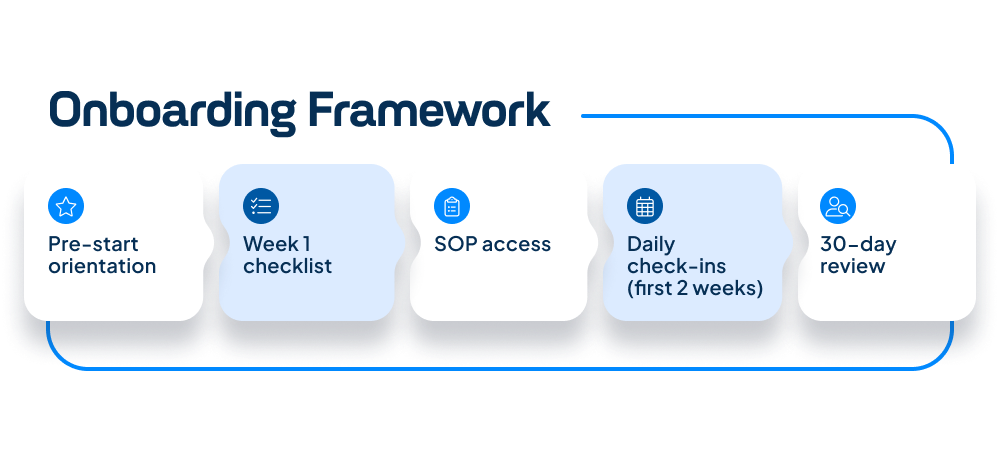Key Takeaways
- Standardizing systems across your practice is the foundation for scalable, stress-free growth.
- An easy-to-follow onboarding process helps new team members become confident and effective without overloading your leads.
- Empowering leaders at every level allows your practice to operate smoothly without constant owner involvement.
- Delegating low-impact tasks frees up time for strategic work that actually moves the business forward.
- A strong culture, built through consistent communication and recognition, keeps teams engaged and aligned.
- Scalable patient experiences rely on simple, repeatable processes that delight without adding pressure to your staff.
- Frameworks like EOS bring clarity and accountability to growing teams.
- Sustainable scaling requires long-term thinking, clear execution plans, and the patience to build solid foundations.
- Virtual support solutions (human professionals) can help implement and maintain these systems without increasing in-house workload.
Scaling a practice isn’t just about growth. It’s about growing without burning out the people who make that growth possible. If you’ve ever felt like adding new services or opening another location just leads to more stress, you’re not alone.
Here are eight strategies that successful optometrists use to grow sustainably while keeping their teams energized, focused, and supported.
1. Standardize Systems Before Scaling
When your foundation is shaky, scaling just multiplies the stress. That’s why the most successful practices don’t start with growth. They start with consistency. Before you think about adding a second location or expanding services, your current setup should run like a well-oiled machine.
A good place to start? Make sure the key parts of your clinic are standardized and easy to replicate. That way, whether you’re onboarding a new staff member or opening a new office, you’re not reinventing the wheel every time.
Core systems to standardize before scaling:
- Patient intake and insurance verification
- Billing, coding, and claims submission
- Optical ordering and delivery workflows
- Dry eye and specialty service protocols
- Contact lens reorders and recalls
- EHR usage and template notes
- Front desk communication and call handling
- Patient follow-up and recall strategy
Think of these as the playbook for your practice. When everyone follows the same script, you get smoother operations and less confusion, no matter how fast you grow.
Bottom line:
You don’t scale chaos. You scale what already works.
2. Invest in Training and Easy-To-Follow Onboarding
When new hires feel lost, they either burn out or become bottlenecks. That’s why having a repeatable onboarding process isn’t just a nice-to-have. It’s a must if you want to grow without stressing your team.
Instead of relying on verbal training and memory, build a plug-and-play system that helps every new team member get up to speed fast, with confidence.
Here’s a simple onboarding framework you can follow:
- Pre-start orientation: Send a welcome email with what to expect, login info, and tools they’ll need
- Week 1 checklist: Include shadowing sessions, task walkthroughs, and role-specific EHR training
- SOP access: Give them access to cheat sheets and guides for repeatable tasks like insurance entry or frame checkout
- Daily check-ins (first 2 weeks): Create space for questions and feedback without overwhelming your leads
- 30-day review: Offer feedback, set growth goals, and clear up any lingering confusion

When onboarding is consistent, training doesn’t have to be time-consuming. It becomes a system that strengthens your practice with every new hire.
Bottom line:
Good onboarding isn’t about hand-holding. It’s about giving your team a clear path forward.
3. Decentralize Ownership with Leadership Layers
If everything flows through you, nothing moves quickly. One of the most impactful things you can do as a practice owner is to stop being the sole decision-maker. Leadership isn’t about having all the answers. It’s about building people who do.
Instead of being the go-to for every question or small fire, build structure through clearly defined leadership roles and effective management1 systems that allow your team to operate independently. That way, they can carry on even if you’re not in the room.
How to start decentralizing ownership:
- Assign clear leadership roles such as lead tech, office manager, or billing lead
- Create role-specific meeting rhythms like weekly huddles or monthly check-ins
- Define who owns what with a responsibility matrix
- Empower leaders to make everyday decisions without needing your approval
When leaders are trusted to lead, staff feel supported, and you get time back to focus on strategy instead of putting out fires.
Bottom line:
You don’t need to be everywhere to stay in control. Strong leaders make your vision scalable.
4. Let Go of Low-Impact Tasks
It’s easy to feel productive when your calendar is full. But if you’re buried in admin work, you’re not steering the ship. Scaling demands focus, and that means letting go of tasks that someone else could do faster, cheaper, or better.
To make that easier, do a quick audit. Look at everything you touch in a typical week and sort it into three buckets: do it, delegate it, or delete it.
| Task | Who Should Handle It | Why |
|---|---|---|
| Insurance verifications | Admin or Virtual Assistant | Doesn’t require clinical judgment |
| Scheduling appointments | Manager or VA | Can be standardized and scripted |
| Staff timesheet approvals | Office manager | Frees up leadership for growth work |
| Diagnosing complex cases | OD | High-leverage and clinical expertise only |
| Writing birthday cards | Delegated team member | Nice touch, but not worth OD time |
Focus on the tasks that require your unique expertise and delegate or offload the rest. That’s how you create space for high-impact thinking.
Bottom line:
If it doesn’t move the business forward, it’s time to pass it on.
5. Use Culture and Communication to Retain and Empower Staff
Scaling isn’t just about numbers. It’s about people. Your team can only carry more responsibility if they feel heard, appreciated, and aligned with your mission. That’s where culture and communication come in.
Even small practices can build strong cultures without gimmicks or cheesy slogans. It’s about clear expectations, frequent feedback, and proper scope2 of work that make your team feel like they matter.
Ways to build culture that scales with you:
- Weekly or monthly 1-on-1s with doctors and team leads
- Internal newsletter with updates, wins, and shoutouts
- Staff MVP awards or surprise appreciation days
- Shared mission trips, local volunteer work, or just lunch together
- Open feedback channels, either digital or anonymous suggestion boxes
- Transparent sharing of performance goals and progress
You don’t need a massive HR department to do this. Just consistency and heart.
Bottom line:
Culture isn’t what you say. It’s what your team feels when you’re not in the room.
6. Build Patient-Focused, Scalable Experiences
Delivering a great patient experience shouldn’t depend on one superstar at the front desk. It should be baked into your process so every visit feels intentional, no matter who’s working that day.
Small touches, when repeated consistently, build trust and loyalty. And when they’re standardized, they reduce the decision fatigue and stress your staff feels trying to improvise on the fly.
Scalable touchpoints to elevate patient experience:
- Send pre-visit confirmations with directions and expectations
- Offer a welcome card on arrival
- Use pre-diagnosis surveys to surface dry eye or other specialty needs
- Automate 24 to 48-hour post-visit follow-ups via text or email
- Offer a “happiness guarantee” for eyewear adjustments or redo policies
- Set up reminders for annual exams, IPL sessions, or treatment follow-ups
These things don’t just delight patients. They make life easier for your team.
Bottom line:
Consistency builds trust. Trust builds practices that grow on referrals, not just ads.
7. Adopt EOS or Similar Frameworks
As your team grows, clarity becomes more important than ever. When people are unclear on who owns what, things fall through the cracks. EOS, or the Entrepreneurial Operating System, helps teams stay aligned and accountable with structured roles and meeting rhythms.
Ways to implement EOS-style thinking:
- Define Visionary and Integrator roles to balance big ideas with execution
- Hold weekly leadership meetings with structured agendas
- Assign ownership to specific KPIs with clear accountability
- Create a scorecard to track team progress at a glance
- Use quarterly team reviews to revisit priorities and reset goals
The goal is not to create more meetings. It’s to create clarity that removes confusion and enables action.
Bottom line:
Structure lets your team stop reacting and start leading.
8. Patience and Long-Term Planning Are Essential
Fast growth without preparation often leads to regret. Whether it’s a rushed hire, a poorly integrated acquisition, or a specialty program that fizzles out, scaling without a solid foundation just adds pressure.
Give yourself permission to slow down and plan with purpose. Set aside time to step back from the clinic, reflect on your goals, and identify what systems or support you need to get there.
Ideas to strengthen long-term focus:
- Block a weekend for a solo strategy retreat
- Build a 12-month execution roadmap by quarter
- Revisit your org chart and fix any unclear or overloaded roles
- Ask yourself which tasks you want off your plate by this time next year
- Meet quarterly with your leadership team to review progress and adjust
Success doesn’t come from sprinting harder. It comes from building with intention.
Bottom line:
Strong foundations don’t slow you down. They let you scale up faster, with fewer cracks to repair.
Final Thoughts: Scaling Is a System, Not a Sprint
Everything you just read is possible with the right structure, the right mindset, and the right support. Scaling well isn’t about grinding harder. It’s about setting your systems and people up to thrive.
That’s what Teem specializes in.
We provide human optometry virtual assistants (not A.I. or bots!) who seamlessly become part of your clinic’s daily routine. They support your team behind the scenes, helping you implement systems, manage admin tasks, streamline communication, and create more margin for growth. Whether you’re strengthening dry eye programs, following up with patients, or managing phone queues, Teem works as an extension of your in-house staff.
You stay focused on patients. We help with the rest.
If You’ve Done All That and Still Feel Stretched Thin
You’ve improved your systems, built a strong team, and created a culture of growth. But the hours still feel short, and the to-do list keeps growing. That’s when it’s time to bring in the extra hands.
Teem gives you the kind of support that keeps your team energized and your operations clean. We don’t replace your team. We make it easier for them to do their best work.
If you’re ready to grow without overloading your people, you can reach out to us HERE.



